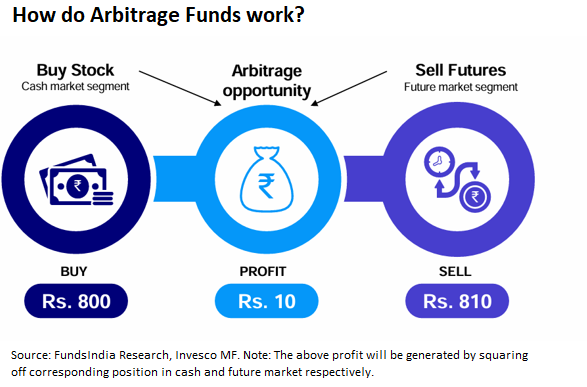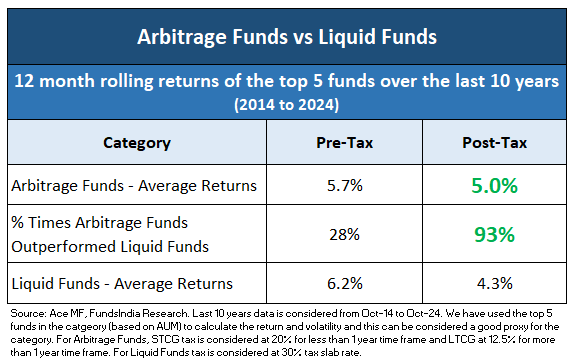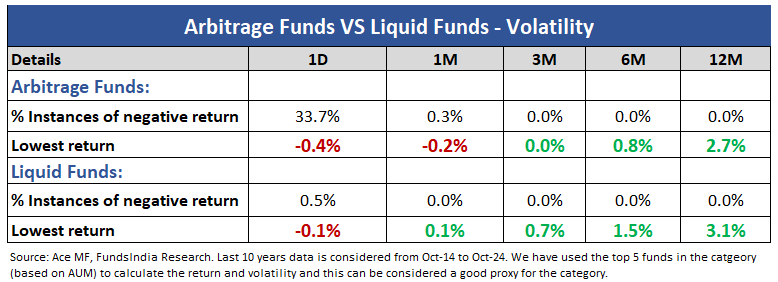What are Arbitrage Funds?
Arbitrage Funds are Debt Oriented Hybrid Funds which make investments in a mixture of Arbitrage and Debt/FDs. They often have 65-75% of their portfolio in ‘Arbitrage’ investments and the remaining 25-30% in ‘Debt/FDs’.
Over a 6 month to 1 12 months interval, arbitrage fund returns are sometimes corresponding to liquid fund returns. However in contrast to liquid funds whose returns are taxed as per your tax slab, arbitrage funds get pleasure from fairness taxation because the funds keep greater than 65% publicity to arbitrage investments.
For any fund to qualify for fairness taxation, the publicity to Indian equities should be above 65% of the portfolio. In Arbitrage funds, although the returns from the arbitrage portion are much like a debt liquid fund, it’s thought-about as fairness from the tax angle because it entails shopping for a inventory within the money market (that’s the inventory market) and promoting it within the futures market.
How do they work?
Arbitrage Funds work on the arbitrage precept the place they benefit from pricing variations of a specific asset, between two or extra markets. It captures danger free revenue on the transaction.
One of the generally used methods by arbitrage funds is the Money Future Arbitrage. Below this technique, arbitrage funds concurrently purchase shares within the money market and promote them within the futures at a barely increased value thereby locking the unfold (danger free revenue) at initiation. At expiry, future value converges with precise inventory value and accordingly acquire is realized.
Instance:
What ought to be the return expectation from arbitrage funds?
Allow us to consider this by evaluating the typical returns of the Arbitrage Funds class (largest 5 funds) vs Liquid Funds class during the last 10 years.
Perception 1: Over 6 month time frames, Arbitrage Funds have underperformed liquid funds on a pre-tax foundation however outperformed on a post-tax foundation.
64% of the instances arbitrage funds have outperformed liquid funds on a post-tax foundation with a median outperformance of 0.2%!
Perception 2: Over 1 12 months time frames, Arbitrage Funds have underperformed liquid funds on a pre-tax foundation however outperformed on a post-tax foundation.
93% of the instances arbitrage funds have outperformed liquid funds on a post-tax foundation with a median outperformance of 0.7%!
Takeaway:
- Over a 6 month time-frame post-tax efficiency of arbitrage funds is comparable/barely higher to liquid funds. Since there is no such thing as a main distinction in returns between liquid funds and arbitrage funds, you’ll be able to select both of the classes.
- However, over 1 12 months time frames, arbitrage funds are a tax environment friendly various and supply significantly better post-tax returns in comparison with liquid funds.
How risky are arbitrage funds in comparison with liquid funds?
We’ve evaluated volatility by observing the situations of day by day or one-day unfavourable returns during the last 10 years.
Every day returns for arbitrage funds have been unfavourable 34% of the instances vs 0.5% of the instances for liquid funds!
Nevertheless, this improves when you enhance your time-frame:
- Month-to-month returns for arbitrage funds have been unfavourable solely 0.3% of the time
- No situations of unfavourable returns for arbitrage funds on a 3 month foundation.
Whereas on a 3 month foundation there aren’t any situations of unfavourable returns in arbitrage funds, to be on the conservative aspect we might recommend a minimal time-frame of atleast 6 months. For those who can maintain and lengthen your time-frame by greater than 1 12 months then you definately additionally get the advantage of long-term capital positive aspects tax.
Takeaway:
- Arbitrage funds within the quick run, are barely extra risky than liquid funds – make investments with a time-frame of atleast 6 months to 1 12 months.
That are the situations beneath which arbitrage fund returns will come beneath strain?
Arbitrage fund returns largely rely upon the spreads between the inventory and the futures market. The spreads can shrink (or worse nonetheless, flip unfavourable) beneath the next conditions:
- Bearish or Rangebound markets – In bearish or range-bound markets, arbitrage alternatives dry up and an arbitrage fund might have to remain invested in debt or maintain money. Additionally, when the market sentiment is bearish, futures might commerce at a reduction (and never a premium) to the money market implying unfavourable spreads.
- Rising AUMs of arbitrage funds – Because the AUMs of arbitrage funds develop, there may be extra money chasing arbitrage alternatives and the spreads are inclined to go down.
- Falling rates of interest – theoretically, future value is spot value + risk-free charge. Therefore, a fall in rates of interest, implies decrease futures value of a inventory and therefore decrease spreads and decreased arbitrage alternative. Even liquid funds will have an effect due to falling rates of interest. So, on a relative foundation arbitrage and liquid fund returns would proceed to be very shut to one another.
Are Arbitrage Funds best for you?
Arbitrage funds might be thought-about if
- You will have a time-frame of >6 months
- You’re searching for higher put up tax returns than liquid funds
- You’re okay with barely increased short-term volatility (vs liquid funds)
Summing it up
- Arbitrage Funds are debt oriented hybrid funds which make investments in a mixture of arbitrage and debt. They often have 65-75% in arbitrage with debt and FD’s accounting for the remaining 25-30%.
- Arbitrage Funds generate returns by participating in arbitrage alternatives and benefiting from the unfold or the differential within the value of a inventory within the spot market versus its value within the futures market.
- Arbitrage funds are a tax environment friendly various (get pleasure from fairness taxation) and supply higher post-tax returns in comparison with liquid funds over 6M-1Y time frames. However over a 6M time-frame the return differential might not be vital.
Make investments with a minimal time-frame of atleast 6 months as they’ve barely increased volatility in comparison with liquid funds over shorter time frames. By extending your time-frame to greater than 1 12 months it’s also possible to benefit from the profit of long-term capital positive aspects tax (no tax for positive aspects lower than Rs 1.25 lakh and 12.5% tax for positive aspects greater than 1.25 lakh)
Different articles it’s possible you’ll like
Submit Views:
2,744









